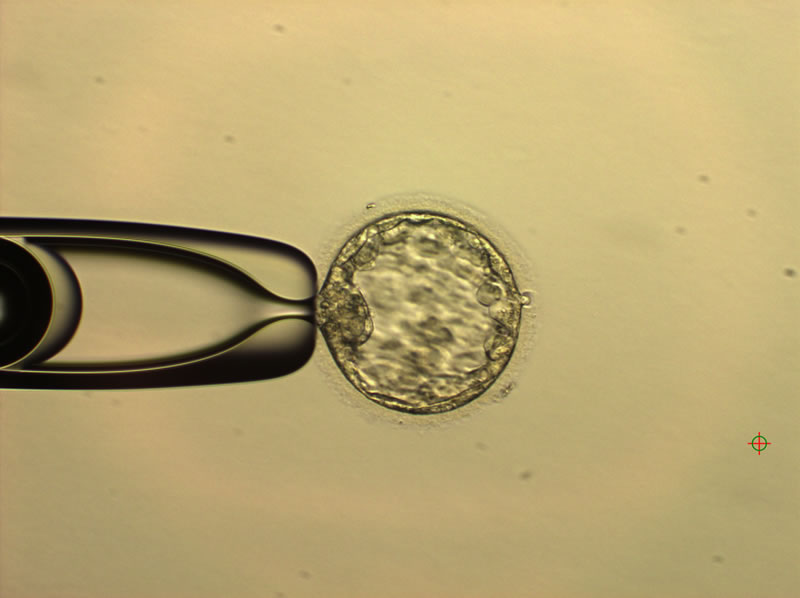Abistatud embrüo koorumine (laser assisted hatching)
Laser Assisted Hatching on laboratoorne protseduur, mida kasutatakse in vitro viljastamise (IVF) käigus, et aidata embrüol paremini kinnituda emaka limaskestale.

Viljastumise ja implantatsiooni (pesastumise) protsesside juures omab tähtsat rolli “Zona Pellucida” (ZP). ZP on imetajate munarakke ümbritsev glükoproteiinidest koosnev kiht, mille moodustamises osalevad nii primaarsed folliikulrakud kui ka primaarne ootsüüt (rakk, mis läbib kaks jagunemist ja moodustab munaraku).
ZP kaks põhilist funktsiooni on viljastumisprotsessi kontrollimine ja embrüo kaitsmine selle varajaste jagunemiste staadiumis.
Viljastumisel käitub ZP mehaanilise ja selekteeriva barjäärina spermatosoidide suhtes ja kui gameetide ühtesulamine on toimunud, siis talitleb ZP n-ö kindlusemüürina, mille sees embrüo on kaitstud mikroorganismide, viiruste ja immuunrakkude eest ning milles embrüo saab areneda kuni kompaktse moorula tekkeni.
Imetaja embrüo on ZP poolt ümbritsetud kuni blastotsüsti staadiumini. Enne implantatsiooni emakas vabaneb embrüo ZP seest – seda protsessi tuntakse termini “hatching” (koorumine) all.
Embrüo nn koorumine (EK) kujutab endast protsessi, mille käigus kasvaval blastotsüstil esinevad mitmed mõõtmete kasvamise-kahanemise tsüklid, indutseerides sellega ZP maatriksi progresseeruvat plastilist deformeerumist.
Kui ZP deformatsioon on saavutanud maksimumi, siis toimub selles lokaalne ZP maatriksi lõhenemine ja blastotsüst väljub ZP seest.
Kui see protsess ei toimu korralikult, siis implantatsiooni ei toimu ja rasedust ei teki.
ZP igasugune funktsionaalne või struktuurne häire võib viia EK puudumisele või puudulikule toimumisele.
EK puudumise võimalikke põhjuseid on liigitatud kahte põhikategooriasse:
- Paksu ZPga (>20µm) embrüotel on langenud võime “koorumist” läbida ja implanteeruda, kusjuures ZP paksus on näidatud korreleeruvat patsiendi vanuse ( >35 aastased), kõrge basaalse FSH (folliikuleid stimuleeriva hormooni) tasemega menstruaaltsükli kolmandal päeval ja ovulatsioonieelse östradiooli tasemega,
- Teiseks põhjuseks peetakse seda, et nii embrüote in vitro kultiveerimine kunstlikus keskkonnas, hüaloronidaasiga töötlus “corona radiata” eemaldamiseks kui ka embrüo külmutamine põhjustavad ZP “tugevnemist”.
Selleks et lahendada EKga seotud raskusi, soovitasid J. Cohen ja tema kaastöötajad kunstlikult augu tekitamist embrüo ZP sisse enne siirdamist.
Viimast meetodit nimetatakse abistatud embrüo koorumiseks (AEK) ehk “assisted hatching”. Selle sekkumise eesmärgiks on võimaldada embrüo efektiivset “koorumist” läbi tekitatud avause.
Kui looduslikult on EK seotud blastotsüsti kasvamise poolt indutseeritud ZP plastilise deformeerumisega seni, kuni tekib ZP katkemine kõige nõrgemas kohas, siis augu ettetegemisel ZP plastilise deformeerumise vajadus kaob.
Blastotsüsti ekspansiooni käigus väljuvad siis embrüonaalsed rakud läbi olemasoleva avause, moodustades kaheksakujulise vahevormi nagu loomuliku EK puhul. Fakt, et ühtegi blastotsüsti ei jää lõpuks ZP “koti” sisse, viitab sellele, et EK mehhanism on selle lõppfaasis blastotsüsti enda poolt kontrollitav.
AEK jaoks on kasutatud väga erinevaid meetodeid – alguses kasutati laialdaselt ZP osalist läbilõikamist mehaaniliselt, klaaskapillaari kasutades. Hiljem valiti ZP keemiline avamine happelise Tyrode’i lahusega nn. ZP drilling ehk puurimine, mida kasutatakse laialdaselt veel praegugi. Mõlemad meetodid nõuavad peeneid oskusi ja on aeganõudvad. Mehaanilised meetodid nagu osaline ZP lahtilõikus, on küll kergesti teostatavad, kuid tulemuseks on erineva suurusega avad või vaod. Kui ava on liiga väike, siis on see kahjulik embrüo terviklikkusele ja võib raskendada embrüo koorumist.
Keemiline meetod, happelise Tyrode’i lahuse kasutamisega ZP avamiseks, loob küll palju standardsemad avad kui mehaaniline lähenemine, ent nõuab hoopis suuremat tehnilist vilumust ning on väidetud, et see võib kahandada embrüote eluvõimet ja kahjustada blastomeere.
Otsingud muuta efektiivsemaks ja ohutumaks kunstliku viljastamisega saadud embrüote implantantsiooni, viisid mitmete erinevate lasersüsteemide valmimiseni, mis kõik on erinevate koolkondade poolt leidnud kasutamist embrüotel enne implantatsiooni. Nende seas esineb erinevus kasutatavate lainepikkuste ning toimimise printsiibi osas.
Kõige laialdasemat kasutust leiab ent nüüdisaegne mittekontaktne infrapunast 1.48 µm lainepikkust kiirgav dioodlasersüsteem, mis võimaldab suurepärase meetodi ZP manipulatsioonideks.
See laser toimib läbi mikroskoobi objektiivi ning on seetõttu hõlpsalt fokusseeritav, võimaldades puutevaba lasermetoodikat. ZP saab avada hetkeliselt üheainsa laseriimpulsiga.
Selle lainepikkusega impulsi eeliseks on madal absorbeerumistase vesikeskkonnas, ent samas omab see piisavat neeldumist indutseerimaks olulisi koelisi efekte ning on kasutatav koekultuuri plastiknõudes ja kultiveerimissöötmes, mis võimaldab embrüote lihtsustatud töötlemist üldkasutatavates kultiveerimiskeskkondades ja -nõudes.
Oluline eelis on ka mõjutamise lühikene aeg (kuni 50 millisekundit), mistõttu pole tarvidust kindlate tingimuste juures isegi munarakku mikromanipulatsiooni hoidja-pipetiga paigal hoida, sest augustamine on hetkeline.
Transmissioonelektronmikroskoopia ei näita mingeid ZP maatriksi ega munaraku avalähedase tsütoplasma ultrastruktuurseid muutusi.
Enamus retrospektiivseid, kindlate diagnostiliste parameetrite järgi valitud patsientide rühmal läbiviidud uurimusi järeldavad, et AEK tõstab nii implantatsiooni määra kui ka kliiniliste raseduste määra valitud populatsioonis.
Osa randomiseeritud, juhuslikult valitud patsiendipopulatsioonidel tehtud uurimusi ent väidavad vastupidist, et AEK ei mõjuta oluliselt implantatsiooni määra ega kliiniliste raseduste määra nendes uurimustes kasutatud populatsioonis.
Ometi näitavad mõlemat laadi uurimused AEK tulemuslikkust osades kindlates halva prognoosiga patsientide allrühmades.
Sellisteks prognostilisteks AEK kasuliku rakendamise kriteeriumideks peetakse kõrget naise vanust (üle 35 aasta), kõrget basaalse FSH (folliikuleid stimuleeriva hormooni) taset menstruaaltsükli kolmandal päeval, embrüote transplantatsioonile eelnenud krüopreservatsiooni (külmutamist), korduvaid EKV ebaõnnestumisi ja paksu ZP-d (>20µm).
Oletatakse ka, et AEK võib muuta embrüo implantatsiooni mitte ainult mehaaniliselt, vaid ka tänu varajasemale embrüo ja endomeetriumi kontaktile.
See on oluline, kuna efektiivseks implantatsiooniks on vajalik sünkroonsus embrüo arengu ja tema emaka endomeetriumiga kontakteerumise vahel.
| Teenus | Hind |
|---|---|
Laser assisted hatching (embrüote “Zona Pellucida” avamine laseriga) | 500 € |
| Broneerimine | |
|---|---|
Broneeri iseteeninduses |

